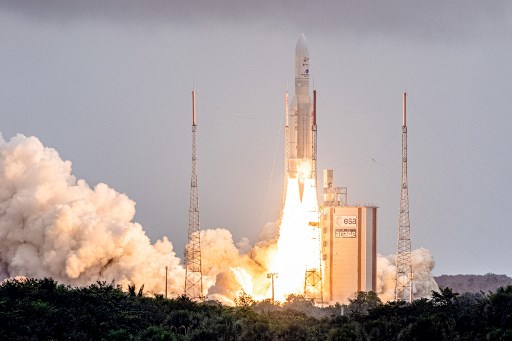Malindi Space Station to play role in historic space mission

Arianespace's Ariane 5 rocket with NASA’s James Webb Space Telescope onboard lifts up from the launchpad, at the Europe’s Spaceport, the Guiana Space Center in Kourou, French Guiana, on December 25, 2021 (AFP)
What you need to know:
- The James Webb Space Telescope (JWST) is a space telescope developed by NASA, European Space Agency (ESA) and the Canadian Space Agency (CSA).
- It is planned to take over from the Hubble Space Telescope as NASA’s flagship mission in astrophysics.
The Space Station in Malindi will play a vital role in the mission of James Webb Space Telescope that launched yesterday on an historic 1.5 million-kilometre journey to space.
This voyage, said to cost an estimated $10 billion (Sh1.1 trillion), aims to establish the formation of the first galaxies, which will in turn provide insights on the potential of outer planets to be habitable by humans.
The Malindi station picked the “first signals” to Earth from the telescope, forming the first point of contact between the vehicle and its observers during the critical mission.
The James Webb Space Telescope (JWST) is a space telescope developed by NASA, European Space Agency (ESA) and the Canadian Space Agency (CSA).
It is planned to take over from the Hubble Space Telescope as NASA’s flagship mission in astrophysics.
Said to be 100 more powerful than its predecessor, this telescope is designed to provide improved infrared resolution and sensitivity, and will boost investigations across the fields of astronomy and cosmology, including observing some of the most distant events and objects in the universe.
At 3:20pm Kenyan time, the telescope launched from an Ariane 5 launch vehicle at Kourou, French Guiana, on the northeastern coast of South America and is now on its way to its target destination, 1.5 million kilometres away from Earth.
As part of ESA’s Estrack network, the 10-meter transmitter in Malindi makes first contact from the ground in the acquisition of the first signal, which is then relayed to other stations within the network across the world.
Space scientists argue that such signals are “our only means of sending commands and bringing data home.”
Lone life in space
Also called Luigi Broglio Space Center (BSC), the Malindi station is Italian-owned. It’s named after its founder and Italian space pioneer Luigi Broglio. The station was developed 60 years ago through a partnership between the Sapienza University of Rome’s Aerospace Research Centre and NASA.
For 21 years between 1967 and 1988, the station served as a spaceport for the launch of both Italian and international satellites.
So, why is Malindi important to the mission?
The station is 10 meters across and “relatively nimble in its pointing”. It’s used by ESA for the launch and early operations phases of a mission’s life, “when a rocket or satellite moves quite quickly overhead” within the Earth’s atmosphere.
Twenty-three minutes after lift-off, Malindi was expected to locate the Ariane 5 launch vehicle in flight, only five minutes before Webb separated from the rocket to begin its lone life in space.
According to phy.org, Malindi will have three phases of visibility with the mission.
“At first, the ESA station will be in a “private call” with Webb for the first hour after separation, after which NASA’s Deep Space Antenna in Canberra, Australia, will join the call. Malindi will [then] switch to backup.”
When the spacecraft is no longer visible from Canberra, Malindi will again take over one more time before
NASA’s Madrid station joins the call.
But why is this mission important?
According to the organisers, NASA, this voyage has four important objectives.
Extensive testing
First, it’s meant to search for light from the first stars and galaxies that formed in the universe after the Big Bang about 13.5 billion years ago.
It’s also expected to study the formation and evolution of galaxies and to understand the formation of stars and planetary systems. The mission also aims to study planetary systems and the origins of life.
“We’re going to be entering a whole new regime of astrophysics, a new frontier; and that is what gets so many of us excited about the James Webb Space Telescope,” said Heidi Hammel, an astronomer in the mission.
The James Webb Space Telescope has been a nearly 30 years journey in the making. Development of the telescope began in 1996, with the launch initially planned for 2007 at a staggering cost of $500 million (Sh55 billion).
A series of delays and cost overruns would, however, backpedal the project for 20 years. These included the need for extensive redesign in 2005 and a ripped sunshield during a practice deployment.
After completion of construction in late 2016, the vehicle has been undergoing extensive testing until recently.
But even with the mission underway, there’s still anxiety over its success. NASA administrator Bill Nelson said this won’t be easy.
“We have to realise there are still innumerable things that have to work and they have to work perfectly. But we know that in great reward, there is great risk. And that’s what this business is all about. And that’s why we dare to explore.”




